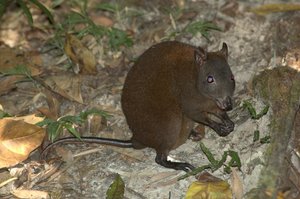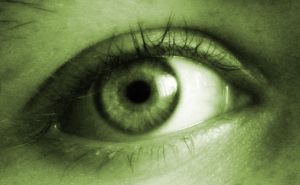Despite its name the musky rat kangaroo is neither a rat or a kangaroo. It is a potoroid marsupial also known as a potoroo or “rat kangaroo”. The potoroid family also includes bettongs.
Physical Characteristics
The musky rat kangaroo measures six and a half to eleven inches long and weighs thirteen to twenty four ounces. Its fur is normally a dark brown but it can vary slightly. The fur on the head has a grayish tint to it. The back feet each have an opposable big toe which is used for gripping especially while it runs. It runs more like a rabbit, bounding on all four feet. The males and the females produce a musky scent which becomes more frequent and prevalent during the breeding season. The tail appears naked and dark brown. It is covered in small scales. It is the only member of its family to have five toes on the hind feet.
Behavioral Characteristics
The musky rat kangaroo is a solitary creature living most of its life alone. Unlike the majority of marsupials, especially the smaller ones, this species is not nocturnal. It sleeps at night and is active during the day.
Life Cycle
The musky rat kangaroo will breed all throughout their breeding season, even while nursing, provided their food supply is abundant. After implantation the second pregnancy or gestation will be delayed until lactation ceases. The pouch life of the musky rat kangaroo is very short. In the wild two young are usually born per litter and two litters a season. In captivity musky rat kangaroos are not known to rear more then a single young at one time. The breeding season takes places in February to July. They have a few days of courtship before mating. Courtship involves the male moving toward the female from the front, then they both stand erect and touch each other’s head and neck with their forepaws. Sexually maturity is reached at eighteen to twenty one months and the species remains able to reproduce for two or three years.
Diet
Most of the musky rat kangaroo’s food is found on the forest floor. Its diet includes fruit that has fallen from the trees, figs, palm nuts, seeds and fungi. This species has one habit that is very rare among marsupials. It hoards food, storing it at different sites around its territory.
Habitat
The musky rat kangaroo lives in a small area in the north east of Australia. It inhabits mostly areas of thick forest.
Conservation
The musky rat kangaroo is classified as least concern on the IUCN (International Union of Conservation of Nature and Natural Resources) red list of threatened species. This classification is the lowest and means the species has a large widespread, population and no current threats that would likely decrease its population in the foreseeable future.
References:
Animal: The Definitive Visual Guide to the World’s Wildlife by, David Burnie and Don E. Wilson
http://rainforest-australia.com/Musky-rat_Kangaroo_Information.htm#Reproduction%20of%20the%20Musky-Rat%20Kangaroo



